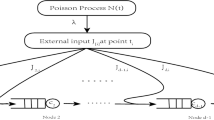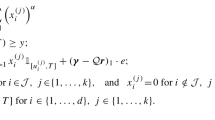Abstract
We use Hamilton equations to identify most likely scenarios of long queues being formed in ergodic Jackson networks. Since the associated Hamiltonians are discontinuous and piecewise Lipschitz, one has to invoke methods of nonsmooth analysis. Time reversal of the Hamilton equations yields fluid equations for the dual network. Accordingly, the optimal trajectories are time reversals of the fluid trajectories of the dual network. Those trajectories are shown to belong to domains that satisfy a certain condition of being “essential.” As an illustration, we consider a two-station Jackson network. In addition, we prove certain properties of substochastic matrices, which may be of interest in their own right.
Similar content being viewed by others
References
Wentzell, A.D. and Freidlin, M.I., Fluktuatsii v dinamicheskikh sistemakh pod deistviem malykh sluchainykh vozmushchenii, Moscow: Nauka, 1979. Tanslated under the title Random Perturbations of Dynamical Systems, New York: Springer, 1984.
Shwartz, A. and Weiss, A., Large Deviations for Performance Analysis: Queues, Communications, and Computing, London: Chapman & Hall, 1995.
Kleinrock, L., Queueing Systems, vol. 1: Theory, New York: Wiley, 1975. Translated under the title Teoriya massovogo obsluzhivaniya, Moscow: Mashinostroenie, 1979.
Jacod, J. and Shiryaev, A.N., Limit Theorems for Stochastic Processes, Berlin: Springer, 1987. Translated under the title Predel’nye teoremy dlya sluchainykh protsessov, Moscow: Fizmatlit, 1994.
Ethier, S.N. and Kurtz, T.G., Markov Processes: Characterization and Convergence, New York: Wiley, 1986.
Puhalskii, A.A., The Action Functional for the Jackson Network, Markov Process. Related Fields, 2007, vol. 13, no. 1, pp. 99–136.
Atar, R. and Dupuis, P., Large Deviations and Queueing Networks: Methods for Rate Function Identification, Stochastic Process. Appl., 1999, vol. 84, no. 2, pp. 255–296.
Ignatiouk-Robert, I., Large Deviations of Jackson Networks, Ann. Appl. Probab., 2000, vol. 10, no. 3, pp. 962–1001.
Collingwood, J., Path Properties of Rare Events, PhD Thesis, Univ. of Ottawa, Canada, 2015.
Bouchet, F., Laurie, J., and Zaboronski, O., Langevin Dynamics, Large Deviations and Instantons for the Quasi-geostrophic Model and Two-Dimensional Euler Equations, J. Stat. Phys., 2014, vol. 156, no. 6, pp. 1066–1092.
Clarke, F.H., Optimization and Nonsmooth Analysis, New York: Wiley, 1983. Translated under the title Optimizatsiya i negladkii analiz, Moscow: Mir, 1988.
Rockafellar, R.T., Convex Analysis, Princeton Math. Series, vol. 28, Princeton: Princeton Univ. Press, 1970. Translated under the title Vypuklyi analiz, Moscow: Mir, 1973.
Bramson, M., Stability of Queueing Networks (Ecole d’ÉtédeProbabilités de Saint-Flour XXXVI-2006), Lect. Notes Math., vol. 1950, Berlin: Springer, 2008.
Anantharam, V., Heidelberger, R., and Tsoukas, P., Analysis of Rare Events in Continuous Time Markov Chains via Time Reversal and Fluid Approximation, IBM Res. Rep. RC 16280, Yorktown Heights, NY, 1990.
Shwartz, A. and Weiss, A., Induced Rare Events: Analysis via Large Deviations and Time Reversal, Adv. in Appl. Probab., 1993, vol. 25, no. 3, pp. 667–689.
Majewski, K. and Ramanan, K., How Large Queue Lengths Build Up in a Jackson Network, Preprint, 2008.
Vinter, R.B., Optimal Control, Boston: Birkhäuser, 2000.
Bazaraa, M.S. and Shetty, C.M., Nonlinear Programming: Theory and Algorithms, New York: Wiley, 1979. Translated under the title Nelineinoe programmirovanie. Teoriya i algoritmy, Moscow: Mir, 1982.
Acknowledgement
The author is grateful to S.A. Pirogov and A.N. Rybko for helpful discussions and advice on improving the presentation.
Author information
Authors and Affiliations
Corresponding author
Additional information
Russian Text © The Author(s), 2019, published in Problemy Peredachi Informatsii, 2019, Vol. 55, No. 2, pp. 82–111.
Rights and permissions
About this article
Cite this article
Puhalskii, A.A. The Geometry of Big Queues. Probl Inf Transm 55, 174–200 (2019). https://doi.org/10.1134/S0032946019020054
Received:
Revised:
Accepted:
Published:
Issue Date:
DOI: https://doi.org/10.1134/S0032946019020054




